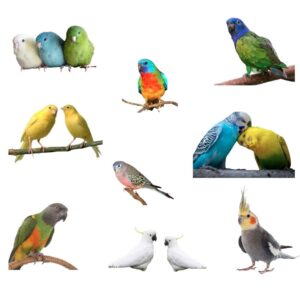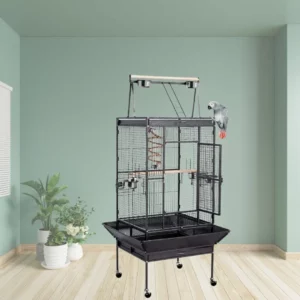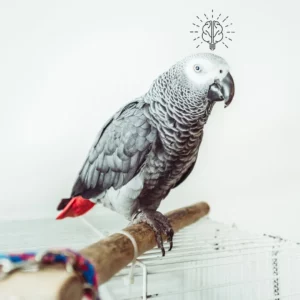Parakeet’s vibrant chirps and playful antics bring joy and companionship into their lives. But as we welcome these gorgeous birds into our homes, a question lingers: how long do parakeets live?
Unfortunately, many parakeet owners face the heartbreaking reality that their beloved companions often live shorter lives than anticipated.
This discrepancy between expectations and reality can be a source of confusion and even guilt for owners. We often wonder, “Am I doing enough? Could I be doing more to extend my parakeet’s life?”
In this article, we embark on a journey to crack the code of parakeet longevity. We’ll explore the factors influencing their lifespan, both in captivity and the wild.
We’ll unveil the secrets to optimizing their care, maximizing their well-being, and ultimately, helping them live long and fulfilling lives.
Table of Contents
How long do parakeets live as pets?
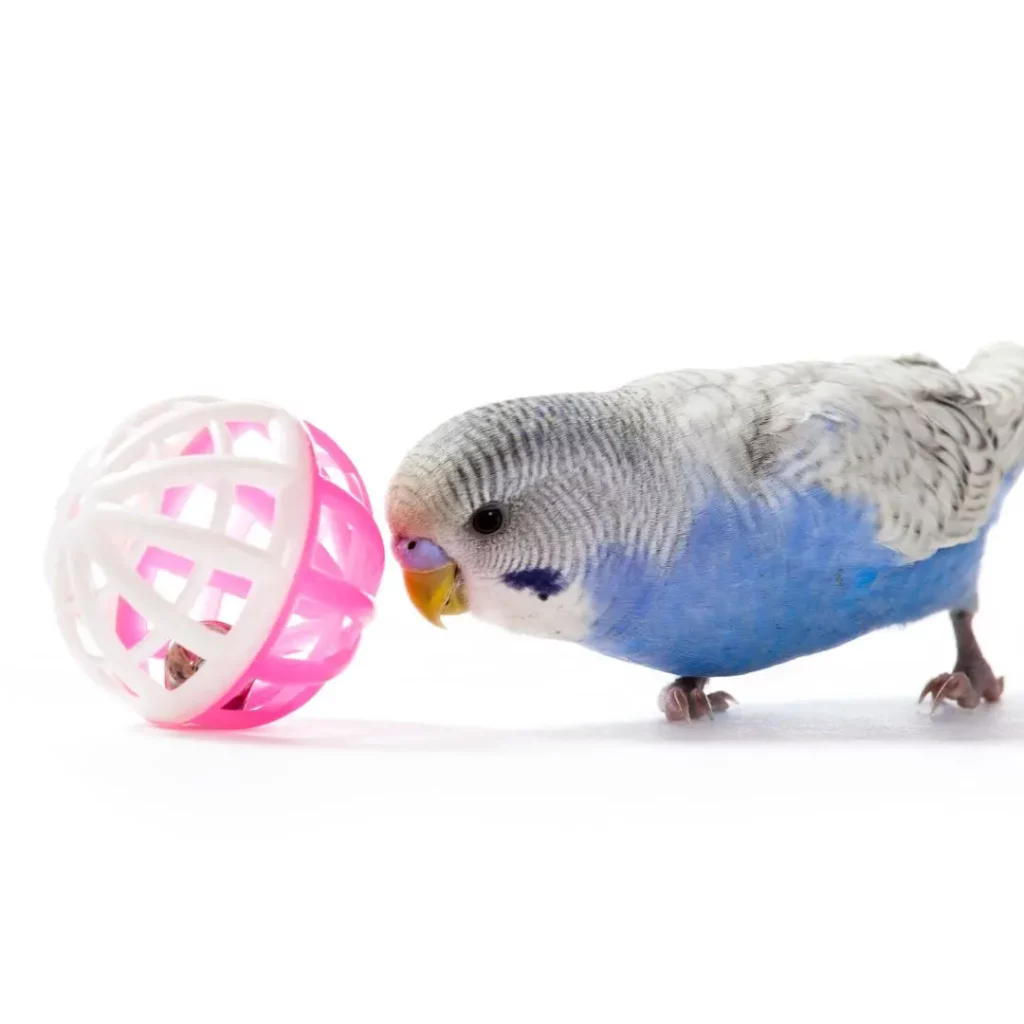
Parakeets typically live 7 to 15 years in the sheltered environment of captivity. But some parakeet breeds can live beyond 20 years, defying the average life expectancy.
On the other hand, it’s important to understand that this lifespan far surpasses their wild counterparts, who generally live four to six years.
This is due to various environmental challenges and predators they often encounter in their natural habitat.
Here’s a list of the most popular pet parakeets and their average lifespan:
- Budgerigars (aka Budgies): 15-20 years
- Sun Conures (one of the most colorful parrots): 15-30 years
- Ringneck Parakeets: more than 20 years (but can often pass the age of 30)
- Monk Parakeets: more than 20 (but can often pass the age of 30)
- Scarlet-chested Parakeets: 10-15 years
- Dusky-headed Parakeets: more than 20 years
What Makes Parakeets In Captivity Live Longer?
Due to a better quality of life, pet parakeets live longer than their wild counterparts. Let’s take a look at some key factors that affect your parakeet’s lifespan.
Diet and Nutrition
Although they mostly eat seeds, parakeets are omnivores, requiring diverse nutrients in their diet. A balanced and healthy diet plan mimicking their natural food sources is critical for your parakeet’s health and longevity.
To help you out, I listed the food you should include in your parakeet’s diet:
- Pellets: Think of pellets as the foundation of your parakeet’s diet. High-quality pellets are packed with important vitamins, minerals, and other nutrients they need to thrive. Opt for brands with various shapes, sizes, and textures to keep things interesting.
- Fruits: Fresh fruits are nature’s candy, bursting with vitamins, antioxidants, and fiber. Apples, pears, bananas, and berries are all safe and delicious choices for parakeets.
But remember that fruits often contain a lot of sugar, so feed them to your birdie(s) in moderation.
- Vegetables: Veggies are packed with vitamins, minerals, and often calcium. They make a great addition to your parakeet’s diet plan.
Here are some valuable options to consider:
- Bok choy
- Broccoli stems and florets
- Brussel sprouts
- Cabbage
- Carrots
- Celery and its leaves
- Cucumber
- Green lettuce
- Green peas
- Kale
- Mustard greens
- Parsley
- Bell Peppers
- Pumpkin
- Radish
- Radishes
- Raw green beans
- Spinach
- Squashes
- Sweetcorn – a whole cob is an enrichment item
- Sweet potatoes (yams)
- Turnips
- Seeds: Seeds come with fats and nutrients, but too many can lead to weight problems. Offer a small amount of a good seed mix containing canary grass, millet, and oats. Avoid mixes with sunflower seeds, which are high in fat.
And here are some mandatory feeding tips to consider:
- Variety is the key: Offer a mix of pellets, fruits, vegetables, and seeds to keep your parakeet’s diet balanced, healthy, and exciting.
- Fresh is best: Be sure always to wash fruits and vegetables thoroughly to get rid of all the potential dirt and pesticides. Don’t forget to remove any seeds or pits, as these are often toxic to birds and can cause poisoning.
- Make changes: Rotate the types of fruits, vegetables, and seeds you offer to create a versatile diet, provide a variety of nutrients, and prevent boredom.
- Offer cuttlebone or mineral blocks: Parakeets can experience calcium deficiency, leading to potential health complications. Cuttlebone and mineral blocks provide plenty of calcium for different health benefits.
Cuttlebone is made from the internal shell of a cuttlefish it’s a natural source of calcium, vital for strong bones and healthy egg production. It also provides a satisfying chewing surface, helping to keep your parakeet’s beak trimmed and healthy.
If you don’t have any cuttlebones yet, here are a few good examples:
Pro tip: Choose a cuttlebone large enough for your parakeet to grasp comfortably and replace it once worn down.
Mineral Blocks contain important minerals like calcium, phosphorus, and iodine, supplementing your parakeet’s diet. Choose a mineral block formulated specifically for parakeets and avoid those containing artificial colors or flavors.
Here are some quality mineral blocks to check out:
- Zoo Med (3 Pack) Mineral Block with Vegetables
- Zoo Med Fruit Bird Banquet Block
- Zoo Med Mineral Block Original Formula Banquet
You should place both cuttlebone and mineral blocks in your parakeet’s cage where they can easily access them. Try attaching them to the cage bars or clip them onto a perch.
Remember: Cuttlebone and mineral blocks are supplements, not replacements for a balanced diet. Consult your veterinarian if you have concerns about your parakeet’s calcium or mineral intake.
- Always have fresh water available: Change it daily and clean the water dish regularly.
Hygiene
Parakeets, like all other pets, require proper hygiene to stay healthy and live longer.
Here are some effective ways to ensure your parakeets stay clean and happy:
- Cage Cleaning: Remove uneaten food, droppings, and soiled bedding daily. Disinfect the entire cage with a bird-safe disinfectant once a week.
Pro tip: Follow the instructions on the disinfectant carefully.
- Bathing: Provide a shallow dish of warm water at least once a week for your parakeets to bathe themselves. Keep in mind that every bird is unique, so if your parakeet doesn’t like taking baths, it’s fine – don’t force them to bathe.
Pro tip: Some parakeets might enjoy misting with lukewarm water from a spray bottle.
- Food and Water Hygiene: Always provide fresh, clean drinking water. Replace it daily. Wash food bowls daily with warm soapy water. Also, store food in a sealed container to prevent contamination.
To help you out, here are a few general hygiene practices to consider:
- Wash your hands thoroughly before and after handling your parakeets.
- Keep their cage in a dust-free and well-ventilated area.
- Avoid using harsh chemicals or cleaning products near your parakeets.
- Regularly schedule checkups with an avian veterinarian for professional advice and healthcare.
Exercise and Stimulation
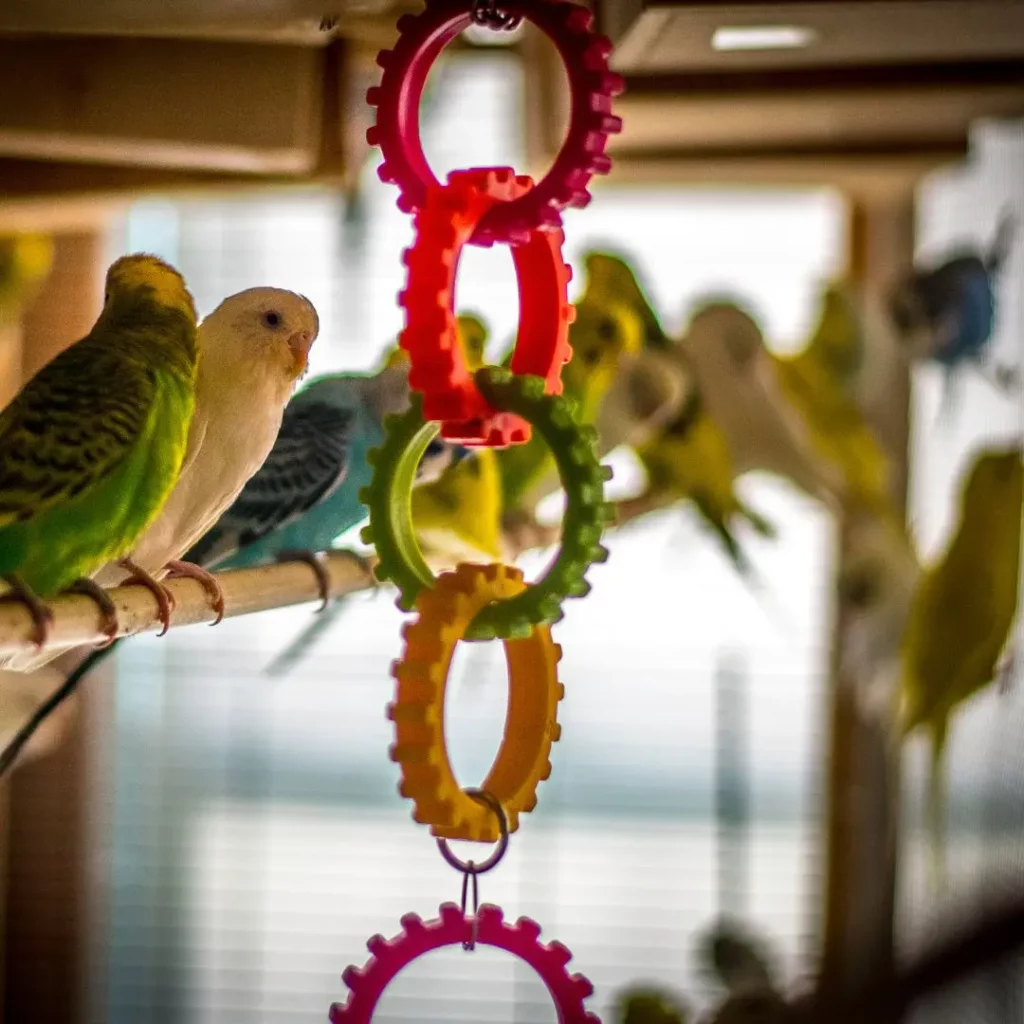
Providing enough exercise and mental stimulation is another excellent way to ensure your parakeet lives a long and happy life – they’re naturally active birds with a strong need for physical and mental stimulation.
Offering a spacious cage equipped with climbing perches, hanging toys, foraging opportunities, and daily flight time outside the cage is critical for their well-being:
- Spacious Cage: Think of your parakeet’s cage not only as their personal house but their own little gym. The bigger the cage is, the more room they have to flap their wings, climb, and explore. A spacious cage allows them to move freely and keep their muscles engaged.
The minimum cage size for a single parakeet should be 18″x 18″x 24″ and the safest bar spacing should be ½ an inch.
- Perches of Different Textures and Sizes: Perches aren’t just for resting! Different sizes and textures (natural wood branches, rope perches, platforms, etc.) encourage your parakeets to use different foot muscles and balance their bodies.
Here are a few quality perches to check out:
This variety also provides mental stimulation as they explore the different positions and movements.
- Toy Time: Toys are more than just fun for your feathered friends; they help with mental and physical stimulation. Try to switch toys occasionally (swings, ladders, foraging toys, puzzle toys) to keep things exciting and prevent boredom.
Not sure which toys to buy for your parakeets? No worries – here are a few ideas:
Pro tip: Choose toys made of safe materials and avoid anything with loose threads or sharp edges.
- Foraging Fun: Foraging is a natural behavior for parakeets in the wild and plays a vital role in their well-being. You can mimic this by hiding treats (seeds, nuts, fruits) inside toys, paper bags, or cardboard boxes.
This encourages their natural foraging instincts, helping them learn to explore, develop and improve their problem-solving and cognitive abilities in general.
- Free Flight Sessions: Nothing beats the freedom of flight! This allows your parakeets to exercise their wings, explore their surroundings, and learn to trust you.
Pro tip: Just close windows and doors and remove potential hazards before letting them out.
Veterinary Care
Regular checkups with an avian vet are critical for maintaining your parakeet’s health. Early detection and treatment of illnesses can significantly improve their lifespan.
Also, preventive measures like vaccinations and parasite control help prevent potential health problems.
You should be aware of several common health problems in parakeets. Let’s check them out.
- Nutritional Deficiencies:
- Symptoms: Lethargy, weight loss, feather plucking, overgrown beak and nails.
- Causes: Diet lacking essential vitamins, minerals, and nutrients.
- Prevention: Feed a balanced diet of high-quality pellets, fresh fruits and vegetables, occasional seeds, and fresh water.
- Respiratory Infections:
- Symptoms: Difficulty breathing, wheezing, coughing, nasal discharge, lethargy.
- Causes: Bacteria, viruses, fungi, dust, drafts, and stress.
- Prevention: Maintain a clean cage, avoid overcrowding, minimize stress, and promptly seek veterinary attention if symptoms appear.
- Feather-Plucking:
- Symptoms: Excessive feather loss on various body parts.
- Causes: Boredom, stress, anxiety, hormonal imbalances, and nutritional deficiencies.
- Prevention: Provide enrichment activities, ensure adequate cage size and stimulation, offer a balanced diet, and consult a veterinarian to rule out medical causes.
- Psittacosis (Parrot Fever):
- Symptoms: Respiratory problems, lethargy, loss of appetite, diarrhea, conjunctivitis.
- Causes: Bacterial infection transmitted through contact with infected birds or their droppings.
- Prevention: Maintain proper hygiene, avoid contact with sick birds, and get regular veterinary checkups.
- Internal Parasites:
- Symptoms: Weight loss, diarrhea, regurgitation, anemia, lethargy.
- Causes: Roundworms, tapeworms, coccidia, and other parasites.
- Prevention: Regular deworming by a veterinarian, good cage hygiene, and avoiding contact with wild birds.
- Bacterial and Fungal Infections:
- Symptoms: Skin lesions, abscesses, feather loss, breathing problems, lethargy.
- Causes: Various bacteria and fungi.
- Prevention: Maintain good hygiene, avoid overcrowding, and promptly seek veterinary attention if symptoms appear.
- Tumors:
- Symptoms: Lumps, bumps, changes in size or shape of organs, difficulty breathing or eating.
- Causes: Age, genetics, and environmental factors.
- Prevention: Regular veterinary checkups and early detection for improved treatment outcomes.
Social Interaction and Bonding

Parakeets are incredibly social and affectionate creatures that require daily interaction and companionship, making them one of the best birds for beginners. This is why enough social interaction helps reduce stress, which can negatively impact their lifespan.
Parakeets can mimic sounds and often learn a few common words and phrases we use, so they’re often known as birds that talk. Being always there and talking with them is mandatory for their social life and mental health.
Genetics
While proper care plays an important role in keeping our feather-buddies live longer, we must acknowledge the influence of genetics on their lifespan.
Inheriting healthy genes from their parents can predispose parakeets to longer lives, highlighting the importance of safe and proper breeding.
This is why you should never engage in unsupervised parakeet breeding – it’s a risky procedure that can drastically impact the life expectancy of a parakeet.
What is the oldest living parakeet?
Charlie holds a Guinis book record of being the longest-living parakeet. He was 29 years old.
How to Tell the Age of Your Parakeet?
Like humans, parakeets go through different stages of life, each marked by unique physical and behavioral changes. While the DNA test is the most accurate solution for finding out a parakeet’s age, there are other ways to tell their approximate age.
Baby (0-6 weeks)
- Appearance: Eyes closed, covered in down feathers, dependent on parents for food and warmth.
- Behavior: Vocalize loudly when hungry, sleep most of the time, and develop coordination.
- Distinguishing features: Smooth, unwrinkled cere (the area around the nostrils), dark-colored eyes with no iris rings.
Young (7-12 weeks):
- Appearance: Develop pin feathers (feathers emerging from follicles), and start growing adult plumage.
- Behavior: Become more active and playful, start exploring their surroundings, and learn to eat solid food.
- Distinguishing features: Cere may start to change color based on gender (blue for males, brown for females), and iris rings begin to develop.
Middle-aged (1-6 years):
- Appearance: Fully feathered, vibrant adult colors, mature size.
- Behavior: Energetic and playful, vocalize often, may start breeding.
- Distinguishing features: Cere is fully colored and textured, and iris rings are complete.
Senior (7+ years):
- Appearance: May develop some feather loss, duller plumage, and slower movements.
- Behavior: Less active, may become quieter, still enjoy interacting with their humans.
- Distinguishing features: Cere may appear crusty or flaky, eyes may become cloudy.
Here are some vet tips regarding a parakeet’s age:
- Remember, individual parakeets may develop at slightly different rates. These age ranges are just a general guideline.
- By understanding the different stages of a parakeet’s life, you can provide them with the best possible care and ensure a long and healthy life for your feathered companion.
- Observe your parakeet’s behavior and physical appearance for any changes that might indicate illness or age-related issues.
- Consult a veterinarian for regular checkups and guidance on proper care at each stage of life.
Signs of Aging in Parakeets
Recognizing the aging signs in your parakeet can help you provide optimal care during their later years – a critical factor that could lead to a longer lifespan.
Here are some of the most common signs of aging in parakeets:
- Decreased activity levels and less playful behavior
- Changes in feather quality, such as dullness, loss of feathers, or changes in coloration
- Loss of appetite or changes in eating habits
- Changes in sleep patterns, such as sleeping more or less than usual
- Difficulty perching or flying
- Lethargy and lack of interest in their surroundings
Remember: By observing these signs and consulting an avian veterinarian, you can ensure your parakeet receives the necessary medical support and adjustments to their care routine, helping you prolong the lifespan of your beloved parakeet.
My Senior Paws is a participant in the Amazon Services LLC Associates Program, an affiliate advertising program designed to provide a means for sites to earn advertising fees by advertising and linking to Amazon.com. We also participate in other affiliate programs which compensate us for referring traffic.

